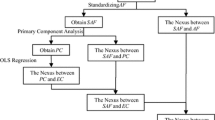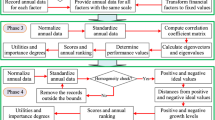Abstract
Decision-making is the key to the development of enterprise. There are many factors of business decisions in thermal power enterprise, and they have different degree of importance. This paper describes the basic principles of principal component analysis. Based on the business characteristics of the thermal power combination, the paper selects seven relevant indicators from the perspective of their own costs and analyzes the factors of business decision in thermal power using principal component analysis. The results demonstrate that the cost factor of business decisions in thermal power enterprise is mainly controlled by the fixed costs, which is together determined by depreciation charges, staff salaries, maintenance costs, materials costs, etc. Secondly, it is controlled by the principal component that determined by the fuel cost. As to the degree of influence on individual factors, the greatest is the fuel costs.
Access provided by Autonomous University of Puebla. Download conference paper PDF
Similar content being viewed by others
Keywords
1 Introduction
Business decision is the focus of management and it is also the key to enterprise development. Business decision in thermal power enterprise, involving wide areas, contents, is affected by the very complex factors. These factors, some from within the enterprise, while others come from outside the enterprise, have influence in different aspects of the business activities. In the enterprise business decision, people must be taken full account of these factors, and carefully study the intrinsic link between them, in order to understand their impact on business decisions in the thermal impact [1]. As to these very complex problems, decision-making just by experience is powerless. So quantitative techniques and methods of modern management must be used to have a comprehensive analysis, thus the business decisions is scientific.
From the point of view of their own costs of thermal power enterprise, the cost of their own, which are closely related factors, is a major factor of business decisions in thermal power enterprise. Therefore, the analysis of key cost factors of thermal power enterprise is of great practical significance to the business development and scientific decision-making in thermal power enterprise. Based on the business characteristics of thermal power enterprise, the paper, using principal component analysis, analyzes the cost factors of business decisions in thermal power enterprise, which provides a reference of scientific business decisions for thermal power enterprise.
2 The Basic Theory of Principal Component Analysis
Principal component analysis is a mathematical transformation method, which given a set of relevant variables by linear transformation into another set of unrelated variables, and these new variables are arranged in descending order according to the order. In the mathematical transformation, the total variance of the variables maintains the same, and the first variable called the first principal component is with the largest variance. The variable called the second principal component is with the second largest variance, and is not related with the first principal component. And so on, the final principal component is with the minimum variance, and is not related with the entire former principal component [2].
Assume there are \( n \) samples, and each sample has a total of \( p \) indicator variables. Thus they can constitute a matrix as flows.
Using \( P \) original variables we can constitute several new integrated variables, which are linear combination of the original variables. Thus, \( {x_1},{x_2},\cdots, {x_p} \) are defined as the original index, and \( {Z_1},{Z_2},\cdots, {Z_m}(m\leqslant p) \) are defined as the new integrated index [3].
3 The Calculation Steps of Principal Component Analysis
3.1 Construct Analysis Matrix
3.2 Standardize the Raw Data
The formula used to standardize:
As a result, we can get the standardized data matrix:
3.3 Calculate the Correlation Coefficient Matrix
3.4 Calculate the Eigen Value and Eigen vectors
3.5 Calculate the Contribution Rate and the Cumulative Contribution Rate
The formula of contribution rate
4 The Formula of the Principal Component
4.1 Analyze the Significance of Each Principal Component
According to the calculated value of each principal component, the sample can be sorted. And according to the significance of the principal component loading on the principal component of integrated indicators, combined with the professional knowledge of the problems, we can make a comprehensive analysis of each principal component to explain the actual significance of them [4].
5 The Analysis of Factors of Business Decision in Thermal Power Enterprise
5.1 Select the Indicators
According to the economic nature and economic use of the cost elements of the thermal power enterprise, the paper selected seven impact factors, which are recorded as \( {x_1},{x_2},\cdots, {x_7} \).
\( {x_1} \): fuel costs; \( {x_2} \): materials costs; \( {x_3} \): depreciation charges; \( {x_4} \): water charges; \( {x_5} \): staff salaries; \( {x_6} \): maintenance costs; \( {x_7} \): others cost [5].
5.2 Analysis
In accordance with the principles of principal component analysis, according to the selected indicators, we can make principal component analysis, taking A company as an example (Table 290.1).
According to Table 290.2, the CRS of the first three principal components is 92.309 %, indicating that they have basically contained all the information of the seven indicators. Among them, the first principal component is the most important, containing the most information (Table 290.3).
From the point of view of the loadings, the first principal component is closely related to depreciation charges, staff salaries, maintenance costs, materials costs, other costs and water charges. Each of the absolute values of their correlation coefficients with the first principal component is in excess of 0.75. Therefore, the first principal component mainly reflects the fixed costs factors of thermal power. And the second principal component is closely related to the cost of fuel. So it can be regarded as variable costs. In the third principal component, water charges, maintenance costs, material costs have a higher absolute value of the loading, which reflects further on the fixed cost factors influence on the basis of the first principal component
It can be seen from the variance contribution rate that the first principal component variance contribution rate is 49.331 %, greater than the second and third principal components of the contribution rate of 33.684 % and 9.295 %. Therefore, the factors of the business decision are mainly controlled by the first principal component, which is controlled by depreciation charges, staff salaries, maintenance costs, materials costs, other costs and water charges together. Then it is controlled by fuel costs.
6 Conclusions
Business decision of thermal power enterprise is a multi-factor, multi-index and complex system. To analyze relying on a single indicator will inevitably raise the one-sidedness. Principal component analysis can ensure the minimum loss of original data, and makes a small number of integrated multi-dimensional variables to replace the original variables after a linear transformation that gives up part of the information. It greatly simplifies the data structure, and objectively determines the weights which avoids subjective and arbitrary.
Through the study above, we can conclude that the factors of business decision in thermal power enterprise are firstly controlled by the fixed cost which is controlled by depreciation charges, staff salaries, maintenance costs, materials costs, etc. And secondly it is controlled by the fuel costs. As far as to the influence degree of individual factors, fuel cost is the greatest one.
References
Shrestha GB, Song Kai L (2007) Strategic bidding for minimum power output in the power market. IEEE Trans Power Syst 16(4):813–818
Edward Jackson J (1992) A user’s guide to principal components. A Wiley Inter-science, New York
Sun J (2000) A note for principal component analysis on multi-dimensional data. Stat Probabil Lett 46:69–73
Jia F, Martin EB, Morris AJ (2000) Non-linear principal component analysis with application to process fault detection. J Syst Sci 31(11):1473–1478
Wen FS, David AK (2010) Oligopoly electricity market production under incomplete information. IEEE Power Eng Rev 21(4):58–61
Author information
Authors and Affiliations
Corresponding author
Editor information
Editors and Affiliations
Rights and permissions
Copyright information
© 2014 Springer Science+Business Media New York
About this paper
Cite this paper
Liu, S., Hao, P. (2014). Study on Factors of Business Decision in Thermal Power Enterprise Based on Principal Component Analysis. In: Zhong, S. (eds) Proceedings of the 2012 International Conference on Cybernetics and Informatics. Lecture Notes in Electrical Engineering, vol 163. Springer, New York, NY. https://doi.org/10.1007/978-1-4614-3872-4_290
Download citation
DOI: https://doi.org/10.1007/978-1-4614-3872-4_290
Published:
Publisher Name: Springer, New York, NY
Print ISBN: 978-1-4614-3871-7
Online ISBN: 978-1-4614-3872-4
eBook Packages: EngineeringEngineering (R0)




